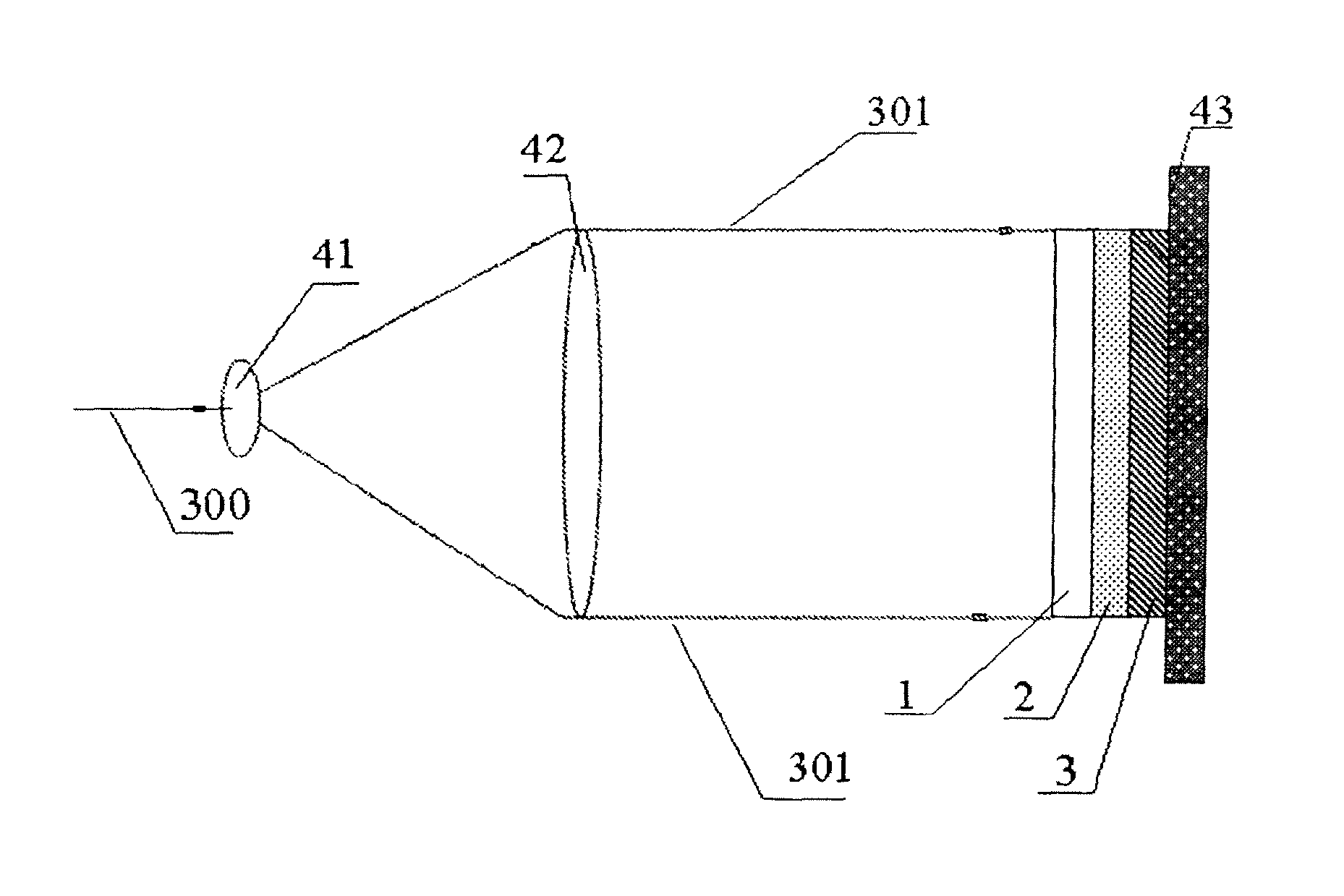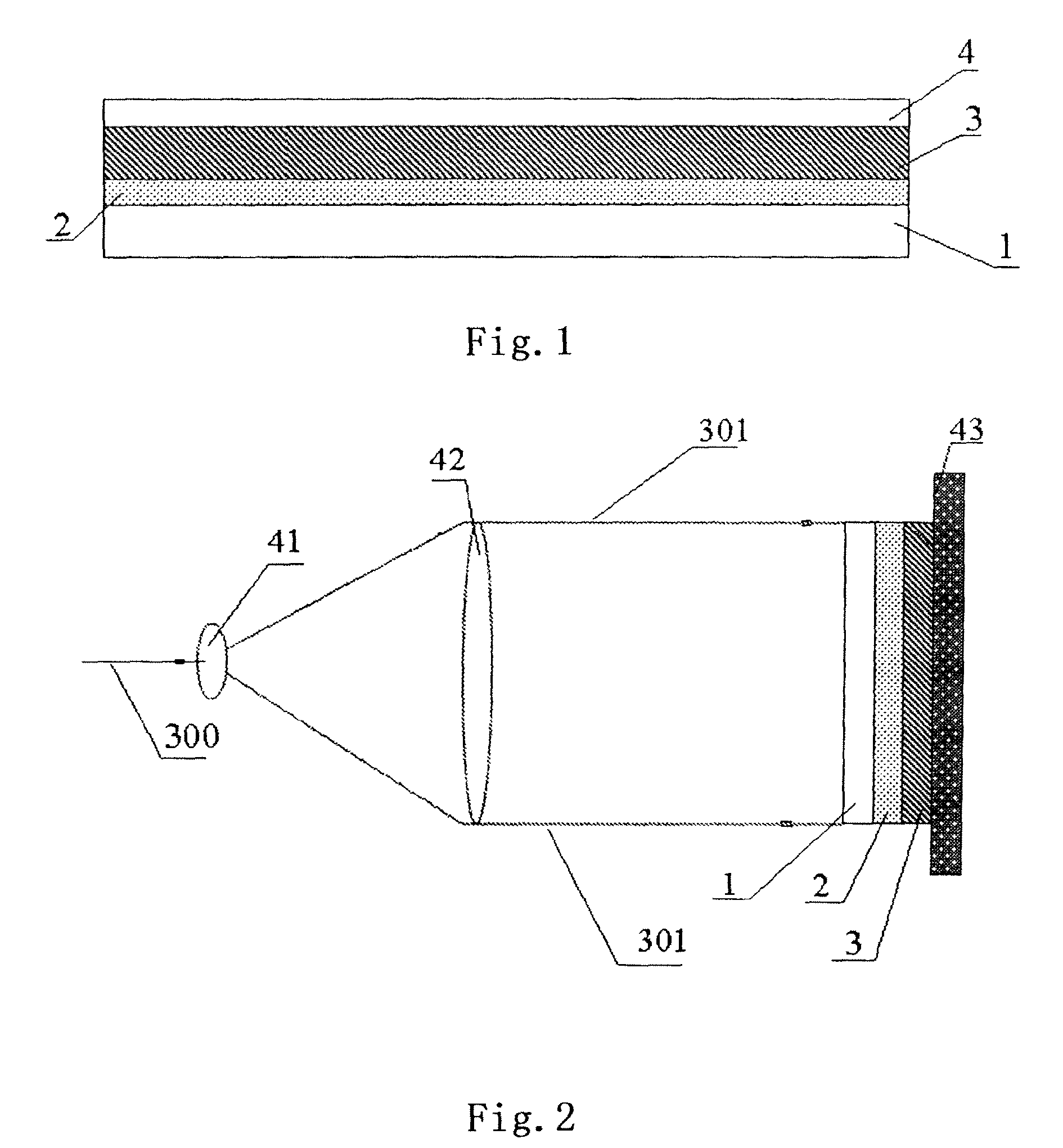Sensitive liquid crystalline polymeric material suitable for reflective hologram recording and the preparing method thereof
a liquid crystal polymer and reflective hologram technology, applied in the field of reflection hologram film, can solve the problems of low diffraction efficiency, low photosensitivity, and about 40%, and achieve the effect of high diffraction efficiency
- Summary
- Abstract
- Description
- Claims
- Application Information
AI Technical Summary
Benefits of technology
Problems solved by technology
Method used
Image
Examples
example 1
[0041]Under the red safe-light with the wavelength of more than 600 nm, 7.6 g (76 wt %) of film forming agent polyvinylacetate-butyl acrylate-acrylic acid ternary copolymer, 0.62 g (6.2 wt %) of p-aminoazobenzene poly(methyl acrylate), 0.73 g (7.3 wt %) of monomer methyl methacrylate, 0.5 g (5 wt %) of monomer trimethylolpropane triacrylate, 0.065 g (0.65 wt %) of photoinitiator 2,4,6-triphenyl imidazolyl dimer, 0.006 g (0.056 wt %) of photosensitizer diethylamino-benzylidene cyclopentanone, 0.017 g (0.17 wt %) of UV absorber 2-hydroxyl-4-methoxybenzophenone, 0.09 g (0.92 wt %) of non-ionic surfactant Fluorad®FC-4430, and 0.28 g (2.8 wt %) of plasticizer diethyl sebacate, were added into a blended solvent (butanone:dichloromethane:methanol=5:1:1, the weight ratio), the solid content was 8% by weight, the resultant mixture was stirred at room temperature to dissolve, the viscosity as measured was 11 cp (25° C.), the resultant product was filtrated to obtain the photosensitive paint f...
example 2
[0046]Under the red safe-light with the wavelength of more than 600 nm, 3.12 g (26.0 wt %) of film forming agent (which is a blend of polyvinyl butyral and cellulose acetate), 3 g (25 wt %) of p-aminoazobenzene poly(butyl acrylate), 2.9 g (24.2 wt %) of monomer butyl methacrylate, 1.82 g (15.1 wt %) of monomer diacrylate of ethoxylated bisphenol A, 0.79 g (6.6 wt %) of the photoinitiator benzoin isobutyl ether, 0.2 g (1.7 wt %) of photosensitizer Michler's ketone, 0.1 g (0.88 wt %) of UV-absorber 2-hydroxyl-4-methoxybenzophenone, 0.019 g (0.16M %) of nonionic surfactant methoxy polyethylene glycol, and 0.065 g (0.54 wt %) of plasticizer diethyl sebacate, were added into a blended solvent (butanone:dichloromethane:methanol=5:1:1, in weight ratio), the solid content was 46.3% by weight. The resultant mixture was stirred at room temperature to dissolve, the viscosity as measured was 28.3 cp (25° C.), and the resultant product was filtrated to obtain the photosensitive paint for use;
[00...
example 3
[0050]The reflection hologram film was evaluated. Specifically, referring to the method of FIG. 2, a holographic-image recording was performed in the photosensitive polymeric film via the coherent light “on-line” recording technique.
[0051]The photosensitive polymeric film for the hologram recording was cut into the sheets of 30*30 nm. After the surface protective film (4) was uncovered, the photosensitive polymeric film was stuck evenly on a reflective mirror 43. A laser having a wavelength of 532 nm was used as the light source. A light beam 300 passed through a beam expander 41 with a pin hole filter and an aspheric collimation lens 42 to form a parallel light beam 301, and then radiated onto the photosensitive polymeric film. The parallel light 301 was incident from the base film 1 and passed through the buffer layer 2 and photosensitive polymer coating layer 3 to reach the reflective mirror 43, and was reflected back into the photosensitive polymer coating layer 3 to form a grat...
PUM
 Login to View More
Login to View More Abstract
Description
Claims
Application Information
 Login to View More
Login to View More - R&D
- Intellectual Property
- Life Sciences
- Materials
- Tech Scout
- Unparalleled Data Quality
- Higher Quality Content
- 60% Fewer Hallucinations
Browse by: Latest US Patents, China's latest patents, Technical Efficacy Thesaurus, Application Domain, Technology Topic, Popular Technical Reports.
© 2025 PatSnap. All rights reserved.Legal|Privacy policy|Modern Slavery Act Transparency Statement|Sitemap|About US| Contact US: help@patsnap.com


